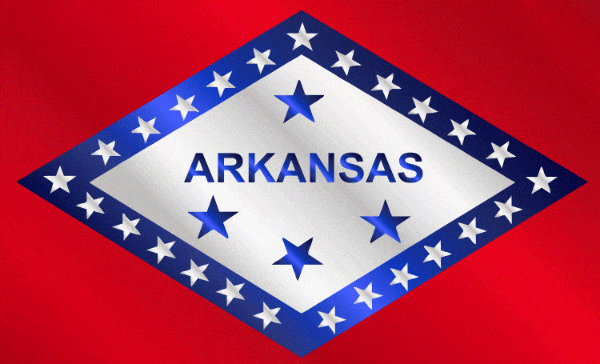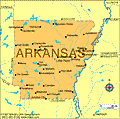Arkansas
State abbreviation/Postal code: Ark./AR Governor: Asa Hutchinson, R (to Jan. 2019) Lieut. Governor: Tim Griffin, R (to Jan. 2019) Senators: Tom Cotton, R (to Jan. 2021); John Boozman, R (to Jan. 2017) Historical biographies of Congressional members Secy. of State: Mark Martin, R (to Jan. 2019) Atty. General: Leslie Rutledge, R (to Jan. 2019) Treasurer: Dennis Milligan, R (to Jan. 2019) Organized as territory: March 2, 1819 Entered Union (rank): June 15, 1836 (25) Present constitution adopted: 1874 Motto: Regnat populus (The people rule)
Nickname: The Natural State Origin of name: From the Quapaw Indians 10 largest cities (2013): Little Rock, 197,357; Fort Smith, 87,650; Fayetteville, 78,960; Springdale, 75,229; Jonesboro, 71,551; North Little Rock, 66,075; Conway, 63,816; Rogers, 60,112; Pine Bluff, 46,094; Bentonville, 40,167 Land area: 52,068 sq mi. (134,856 sq km) Geographic center: In Pulaski Co., 12 mi. SW of Little Rock Number of counties: 75 Largest county by population and area: Pulaski, 388,953 (2012); Union, 1,055 sq mi. State parks: 51 Residents: Arkansan 2015 resident population: 2,978,204 2010 resident census population (rank): 2,915,918 (32). Male: 1,431,637; Female: 1,484,281. White: 2,245,229 (77.0%); Black: 449,895 (15.4%); American Indian: 22,248 (0.8%); Asian: 36,102 (1.2%); Other race: 99,571 (3.4%); Two or more races: 57,010 (2.0%); Hispanic/Latino: 186,050 (6.4%). 2010 population 18 and over: 2,204,443; 65 and over: 419,981; median age: 37.4. |
Spaniard Hernando de Soto was among the early European explorers to visit the territory in the mid-16th century, but it was a Frenchman, Henri de Tonti, who in 1686 founded the first permanent white settlement—the Arkansas Post. In 1803 the area was acquired by the U.S. as part of the Louisiana Purchase.
Part of the Territory of Missouri from 1812, the area became a separate entity in 1819 after the first large wave of settlers arrived. The next several decades were marked by the development of the cotton industry and the spread of the Southern plantation system west into Arkansas. Arkansas joined the Confederacy in 1861, but from 1863 the northern part of the state was occupied by Union troops.
Food products are the state's largest employing sector, with lumber and wood products a close second. Arkansas is also a leader in the production of cotton, rice, and soybeans. It also has the country's only active diamond mine; located near Murfreesboro, it is operated as a tourist attraction.
Hot Springs National Park and Buffalo National River in the Ozarks are major state attractions. Blanchard Springs Caverns, the Historic Arkansas Museum at Little Rock, the William J. Clinton Birthplace in Hope, and the Arkansas Folk Center in Mountain View are also of interest. New in 2011 is the Crystal Bridges Museum for American Art, designed by Moshe Safdie, which houses the collection of Walmart heiress Alice Walton.
In 2008, Arkansas joined the unfortunate list of states that have suffered school shootings: four men were charged with capital murder and other felonies for the fatal shootings of two students and wounding of a third near a University of Central Arkansas dormitory.
Flash floods swept through Albert Pike Recreation Area, killing 19 in 2010. One year later, the Mississippi River flooded more than 1 million acres and 63 counties were declared disaster areas.
See more on Arkansas:
Encyclopedia: Arkansas
Encyclopedia: Geography
Encyclopedia: Economy
Encyclopedia: Government
Encyclopedia: History
Monthly Temperature Extremes
All U.S. States: Geography & Climate
Printable Outline Maps
Record Highest Temperatures
Record Lowest Temperatures
Highest, Lowest, and Mean Elevations
Land and Water Area
All U.S. States: Population & Economy
Historical Population Statistics, 1790–Present
Per Capita Personal Income
Minimum Wage Rates
State Taxes
Federal Government Expenditure
Percent of People in Poverty
Births and Birth Rates
Homeownership
Percentage of Uninsured by State
All U.S. States: Society & Culture:
Most Livable States
Healthiest States
Most Dangerous States
Smartest States
Crime Index
Residency Requirements for Voting
Compulsory School Attendance Laws
Driving Laws
National Public Radio Stations
Selected famous natives and residents:
- G. M. “Broncho Billy” Anderson actor;
- Maya Angelou author and poet;
- Daisy Bates social reformer;
- Dee Brown author;
- Helen Gurley Brown editor;
- Dale Bumpers governor and senator;
- Glen Campbell singer;
- Hattie Caraway first elected woman senator;
- Johnny Cash singer;
- Eldridge Cleaver social activist;
- William Jefferson Clinton former president;
- William Darby founder of the Darby Rangers;
- Dizzy Dean baseball player;
- Orval Faubus governor;
- John Gould Fletcher poet;
- J. William Fulbright former senator;
- John Grisham author;
- Tess Harper actress;
- John H. Johnson publisher;
- E. Fay Jones architect;
- Scott Joplin composer;
- Alan Ladd actor;
- Douglas MacArthur general;
- Patsy Montana singer;
- Isaac C. Parker judge;
- Albert Pike pioneer teacher and lawyer;
- Scottie Pippen NBA player;
- Dick Powell actor;
- Mary Steenburgen actress;
- Billy Bob Thornton actor;
- Sam Walton founder of Wal-Mart;
- William C. Warfield concert singer and actor.


